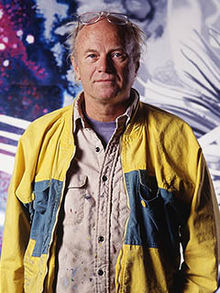James Rosenquist
| James Rosenquist | |
|---|---|

Photo of James Rosenquist in his Aripeka, Florida studio, 1988. Photo by Russ Blaise
|
|
| Born |
November 29, 1933 Grand Forks, North Dakota |
| Nationality | American |
| Education | Minneapolis College of Art and Design, University of Minnesota, Art Students League of New York |
| Known for | Painting, printmaking, drawing |
| Movement | Pop-art |
James Rosenquist (born November 29, 1933) is an American artist and one of the protagonists in the pop-art movement. Rosenquist was a 2001 inductee into the Florida Artists Hall of Fame.
He was born in Grand Forks, North Dakota, and grew up as an only child. His parents, Louis and Ruth Rosenquist, of Swedish descent, were amateur pilots and moved from town to town to look for work, finally settling in Minneapolis. His mother, who was also a painter, encouraged her son to have an artistic interest. In junior high school, Rosenquist won a short-term scholarship to study at the Minneapolis School of Art and subsequently studied painting at the University of Minnesota from 1952 to 1954. In 1955, at the age of 21, he moved to New York City on scholarship to study at the Art Students League.
To be creative is to be accepting, but it’s also to be harsh on one’s self. You just don’t paint colors for the silliness of it all. - James Rosenquist
From 1957 to 1960, he earned his living as a billboard painter. This was perfect training, as it turned out, for an artist about to explode onto the pop art scene. Rosenquist deftly applied sign-painting techniques to the large-scale paintings he began creating in 1960. Like other pop artists, Rosenquist adapted the visual language of advertising and pop culture (often funny, vulgar, and outrageous) to the context of fine art. Rosenquist achieved international acclaim in 1965 with the room-scale painting F-111.
Rosenquist has said the following about his involvement in the Pop Art movement: "They [art critics] called me a Pop artist because I used recognizable imagery. The critics like to group people together. I didn't meet Andy Warhol until 1964. I did not really know Andy or Roy Lichtenstein that well. We all emerged separately."
...
Wikipedia
